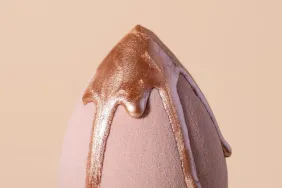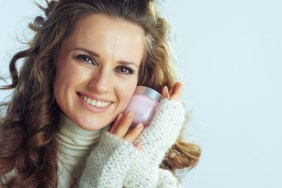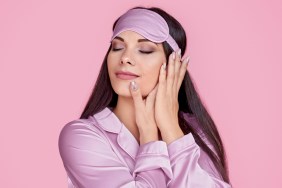If you’ve been to a spa, you’ve likely seen a section with soft-but-firm bristle brushes — they’re not for your hair! These usually wooden brushes are for your skin (including your face). Grazing one of these wooden brushes against your skin, a process called dry brushing, is said to help with a long list of afflictions.
“I recommend dry brushing because it’s very quick, affordable and a simple way to promote optimum skin and boost circulation while helping to reduce the appearance of cellulite,” says ELEMIS VP of Global Education Annet King. “It helps the penetration of your body oils and products and helps to purge waste, salt and toxins.”
[ Ask an Expert: How to Get Rid of Cellulite Once and for All ]
How to Dry Brush
The best time of day to dry brush is in the morning before you shower to help energize the system and wake up your body and mind. “Start at the bottom of the feet and move up to your legs in an upward motion [if cellulite is of concern, give that area a little extra love],” says celebrity esthetician Gina Mari. “Once you reach the stomach, start moving the brush in a circular motion. Next, brush your arms moving toward your chest and onto your chest in a circular motion. You can also brush your neck area starting in the back and moving forward.”
Brush firmly in long strokes with the brush flat on your skin. You may want to soothe your skin by stroking over it with your hand as the brush can leave a tingling sensation — be careful, however, not to put too much pressure on the brush; you should never feel pain as that will cause breakage and/or redness. Note it’s important not to dry brush in the shower or when skin is damp as this can damage the bristles of the brush. Mary Coyne, spa supervisor at Ashford Castle, also recommends using a tea tree spray or disinfectant spray to remove the dead skin cells after use. The entire dry brushing process should take two to three minutes.
Not Just for Your Body
Most people think of dry brushing as a practice for the body, but it’s actually something you can do on your face as well. You’ll want to once again use circular motions, but this time starting at the décolleté and moving up to your forehead and then back down. Dry brushing on your face will make your skin care products penetrate your skin more readily, which means that after you do it, apply your anti-agers and moisturizers. And remember not to use the same brush on your face as you do your body! Aside from potentially causing a breakout, you’ll want to use a slightly softer brush for your face.
And before you stress out about your already busy schedule, dry brushing isn’t something you have to be doing every day to reap benefits! In fact, it’s recommended to start practicing this treatment sparingly. “I generally recommend starting once a week and increasing slowly (up to daily) as your skin tolerates because dry brushing is a form of exfoliation — daily brushing can be too much and one to three times per week is sufficient for most people,” says RealSelf contributor Dr. Sejal Shah.
[ What Is Exfoliation? Everything You Need to Know ]
That said, it will take consistency to see lasting results, but you’ll immediately notice softer and smoother skin because it increases blood flow. Over time skin should be smoother, more hydrated and tighter. Many people also claim this practice helps with their digestion.
Dry Brushing Isn’t for Everyone
It isn’t for everyone, however. Anyone with skin conditions, such as eczema or psoriasis should avoid this practice or, at the very least, avoid affected areas. Cynthia King, master massage therapist at Savor Spa, adds that pregnant women should also be extra cautious as should anyone with open wounds, broken, bruised or thinning skin or someone who is weak, sick or elderly. “Moreover, it’s important to note that if you have sensitive skin that’s prone to flare-ups, dry brushing may cause irritation or over-drying of the skin,” says Shah. “Also in your teens and early 20s, your skin’s outer layers will automatically turn over so you likely don’t need the additional exfoliation that dry brushing provides.”
Choose the Right Dry Brush
Once you’ve committed yourself to trying dry brushing, you need to pick a proper brush. Many dry brushes come without a handle, but often people actually find that opting for one with a long handle is better as it allows you to more readily reach those hard-to-get spots. “I recommend getting one of two body brushes: ELEMIS and VOYA,” says Coyne. “Both brushes have natural cactus bristles, which tend to be the most popular type of brushes. The ELEMIS body brush has a detachable stick, which is very useful to reach more difficult areas of the body.”
Remember, if you’re planning on dry brushing from head to toe, you’ll need two brushes. If you’re worried about sensitivity, Shah suggests starting with a washcloth and working your way up to something stiffer once you get the desired effect.
Benefits of Dry Brushing
While many of the effects of dry brushing have been proven — like exfoliated skin — not all the claims surrounding this Ayurveda-inspired practice are backed up. “Dry brushing can have an aspect of massage and massage can temporarily increase blood flow and circulation and stimulate the lymphatic system,” says Shah. “However, when it comes to ridding the body of toxins, the body has its own efficient system in place in which the liver plays the primary role and there’s no evidence that dry brushing has any impact on this process.”
It’s also important to note that while dry brushing will likely help with cellulite more than anything you’ll find in a tube or bottle in the short-term, the only long-term way to rid yourself of those pesky lumps and bumps is to build up the muscles underneath the fat tissue (yes, that means doing lunges and squats).








